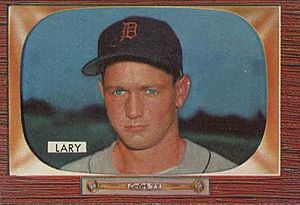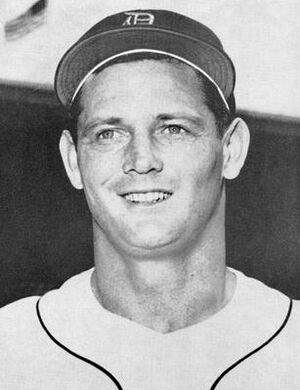Frank Lary facts for kids
Quick facts for kids Frank Lary |
|||
|---|---|---|---|
 |
|||
| Pitcher | |||
| Born: April 10, 1930 Northport, Alabama, U.S. |
|||
| Died: December 13, 2017 (aged 87) Tuscaloosa, Alabama, U.S. |
|||
|
|||
| debut | |||
| September 14, 1954, for the Detroit Tigers | |||
| Last appearance | |||
| September 21, 1965, for the Chicago White Sox | |||
| MLB statistics | |||
| Win–loss record | 128–116 | ||
| Earned run average | 3.49 | ||
| Strikeouts | 1,099 | ||
| Teams | |||
|
|||
| Career highlights and awards | |||
|
|||
Frank Strong Lary (born April 10, 1930 – died December 13, 2017) was a famous Major League Baseball pitcher. He played for the Detroit Tigers for many years. He also played for the New York Mets, Milwaukee Braves, and Chicago White Sox.
Frank Lary was known for being a great pitcher. In 1956, he led the American League with 21 wins. He had an even better year in 1961, winning 23 games. He was chosen to be an All-Star in both 1960 and 1961. In 1961, he also won a special award called the Gold Glove Award for his excellent fielding. People called him "Taters," "Mule," and his most famous nickname, the "Yankee Killer." He earned this name because he was incredibly good at beating the New York Yankees.
Contents
Early Life and Baseball Beginnings
Frank Lary was born in Northport, Alabama, in April 1930. He was one of seven children in his family. He grew up on a farm with his six brothers. His father, Joseph Milton "Mitt" Lary, was a cotton farmer. He used to be a semi-pro pitcher himself. He taught Frank and his brothers how to play baseball.
Frank went to Tuscaloosa County High School. Then he played baseball for the University of Alabama. His older brother, Al Lary, also played baseball. Frank had a great record of 10 wins and 1 loss in 1950. He also won two games in the College World Series. After two years, Frank left college to play professional baseball.
Starting in the Minor Leagues
After his success in college, Frank Lary signed a contract to play professional baseball. He joined the Toledo Mud Hens, a team connected to the Detroit Tigers. He started his minor league career in Thomasville, Georgia. He won four games in a row there. Then he moved to Jamestown, New York, where he had a 5-2 record.
Frank missed the 1951 and 1952 seasons. This was because he served in the U.S. Army. When he returned, he played for the Buffalo Bisons. In 1953, he won 17 games and even pitched a no-hitter! A no-hitter is when a pitcher plays an entire game without allowing the other team to get any hits. In 1954, he won 15 games. He won 10 of his last 12 games that year.
Playing for the Detroit Tigers
Frank Lary joined the Detroit Tigers in 1954. He made his first Major League game appearance on September 14. He played for the Tigers for parts of 11 seasons. His 123 wins for the team rank him among the top pitchers in Tigers history.
In 1955, Lary became a regular starting pitcher for the Tigers. He finished the season with 14 wins and 15 losses.
In 1956, Lary had an amazing season. He won 21 games and lost 13. He was the first Tigers pitcher to win 20 games since 1948. He led the American League in several important pitching stats. These included wins (21), games started (38), and innings pitched (294).
The "Yankee Killer"
During his time with the Tigers, Frank Lary became famous as "The Yankee Killer." From 1955 to 1961, he had an incredible record of 27 wins and only 10 losses against the New York Yankees. This was especially impressive because the Yankees were one of the best teams. They won six American League championships during those years.
In 1956, Lary beat the Yankees 5 times while only losing once. The Yankees had a great record of 97 wins that year. In 1958, he was even better against them, with 7 wins and 1 loss. He was the first pitcher since 1916 to win seven games against the Yankees in one year.
Frank Lary was also a good hitter for a pitcher. On May 12, 1961, he helped his team beat the Yankees 4-3. He hit a home run in the ninth inning! Even the Yankees manager, Casey Stengel, knew how tough Lary was. He once changed his star pitcher's schedule just so he wouldn't have to face Lary. Stengel said, "If Lary is going to beat us anyway, why should I waste my best pitcher?"
Lary also had another nickname, "Taters." This happened on a road trip in 1955. A teammate saw him write "Taters" instead of "potatoes" on a dining car order. The nickname stuck!
In 1960, Lary was chosen as an All-Star for the first time. He led the American League in games started (36) and complete games (15). A complete game is when a pitcher pitches the entire game without anyone else taking over.
In 1961, Lary had the best season of his career. He won 23 games and lost only 9. This was the most wins he ever had in a season. He also led the league with 22 complete games. He was again selected for the American League All-Star team. And he won the Gold Glove Award for his excellent fielding. He finished third in the voting for the Cy Young Award, which goes to the best pitcher.
From 1955 to 1961, Frank Lary was one of the busiest pitchers in baseball. He led the American League in wins (117), complete games (115), and innings pitched. He started more than 30 games every year during this time.
Later Years with the Tigers
In 1962, all that hard work started to affect Lary. He began to have shoulder problems. He was placed on the disabled list in August 1962. He started the 1963 season in the minor leagues. When he returned to the Tigers, he had a record of 4 wins and 9 losses. His shoulder problems continued to affect his performance.
Playing for Other Teams
In May 1964, the New York Mets bought Frank Lary from the Tigers. He had 2 wins and 3 losses for the Mets. He even pitched a two-hit shutout in his last game for them that season. A shutout is when a pitcher prevents the other team from scoring any runs.
In August 1964, the Mets traded Lary to the Milwaukee Braves. He was then reacquired by the Mets in March 1965. He had 1 win and 3 losses for the Mets in 1965. In July 1965, the Mets traded Lary again, this time to the Chicago White Sox. He played in 14 games for the White Sox and had 1 win and 0 losses. This was his final season in Major League Baseball.
Career Highlights
Over his 12 seasons, Frank Lary had a total of 128 wins and 116 losses. His earned run average (ERA) was 3.49, which is a measure of how many runs a pitcher allows per game. He pitched 21 shutouts and had 1,099 strikeouts.
Frank Lary was also a decent hitter for a pitcher. He had a .177 batting average. He hit 6 home runs and had 54 RBI (runs batted in).
Pitching Style
When Frank Lary first started, he threw a hard fastball and a slider. Later, his pitching coach, Johnny Sain, taught him to throw a knuckleball. A knuckleball is a special pitch that moves in unpredictable ways. Lary worked hard to master this pitch. He became so good at it that he could throw it for a strike.
After Baseball
After his baseball career, Frank Lary worked as a coach and scout for different teams. Later, he lived in Tuscaloosa, Alabama. He started his own construction business there. In 1986, he was working for a company that paved roads.
Frank Lary passed away on December 13, 2017, at the age of 87. He died from pneumonia in a hospital in Tuscaloosa, Alabama.
See also
- List of Major League Baseball annual wins leaders
- List of Major League Baseball career hit batsmen leaders


